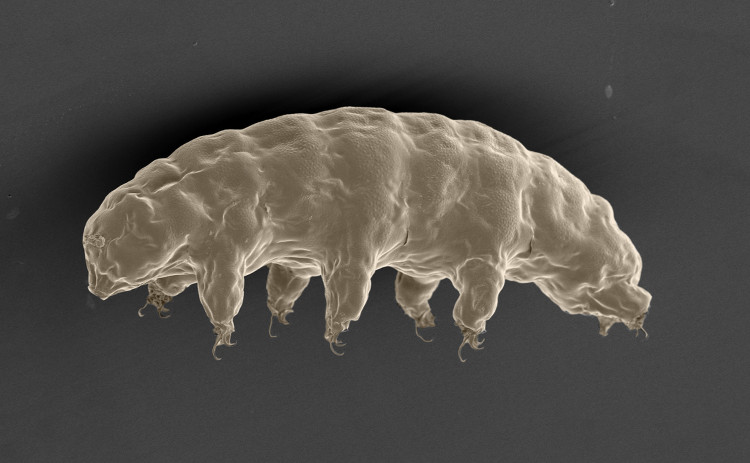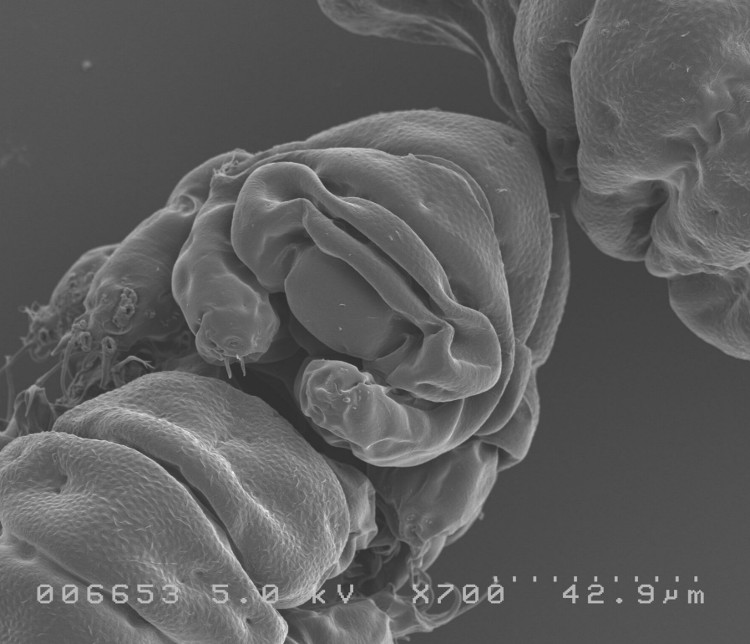Transplanting proteins from the 'longevity' creature into human cells, surprised by the results
Tardigrades, also known as "water bears", are microscopic animals with the ability to withstand the harshest environmental conditions.
Researchers from Japan have now created the most accurate image of the tardigrade genee, revealing the great tricks it uses to survive.

Observation image under the scanning electron microscope (SEM) of the incredible Tardigrade.(Photo: Tanaka S, Sagara H, Kunieda).
In a new study published in Nature Communications, geneticist Takekazu Kunieda and his colleagues from Tokyo University presented a genetic analysis of Ramazzottius variornatus, the most enduring and capable species. the most powerful of all Tardigrades.
Research results indicate that Tardigrades has developed a unique set of strategies to cope with extremely difficult conditions, including the use of a protein to protect DNA from the destruction of the radiation.
When the researchers implanted this protein into human cells in the culture medium, the same protection still applies - this finding offers potential applications for cell preservation methods, Genetic therapies and the development of genetically modified science.
Tardigrades are incredible admirable microscopic creatures that are able to withstand the worst that nature can bring to them. Classified as "extremophiles" , they can survive in frozen state, complete dehydration, radioactivity, even in space vacuum. Tardigrades are an ancient creature different from the ancestors of the pre-Cambrian period (about 600 million years ago), and may have developed their unique genee over a long period of time.

Face / photo in front of the tardigrade.(Photo: Takekazu Kunieda).
Earlier this year, scientists successfully revived a tardigrade that had been frozen for more than three decades - a new record for this persistent creature.
For that reason, it is understandable that scientists are very curious about Tardigrades, studying this ancient creature that can tell us life on other planet, and how we can make the most of it. Tardigrade biology in medicine and genetics.
This is not the first time scientists have identified the sequence of tardigrade genes. Last year, geneticists from the North Carolina State University at Chapel Hill conducted a similar study, revealing the really strange genetic structure of the tardigrade. The researchers found that 17.5% of the tardigrade genome comes from other organisms, including plants, fungi, bacteria, and viruses. Water bears seem to have achieved so many characteristics that are not the result of their own evolution, but through (the hard work of other organisms) in a process called dimensional transformation. horizontal

The tardigrade is walking on the moss.(Photo: Takekazu Kunieda).
New research from the University of Tokyo defies this hypothesis, indicating that the majority of the characteristics of tardigrade are actually their own, not the result of horizontal gene transfer.
New research is different from the previous one at many very important points. The researchers used one of the most resilient tardigrade species on the planet, R. varieornatus, while previous research was observing Hypsibius dujardini, one of the possible freshwater tardigrade species. the lowest capacity.
- Transplanting the human brain to
- Upgrade the mouse intelligence
- Find a drug that extends your mouse's life expectancy by 35%, coming soon for humans?
- Cancer drugs from proteins found in human milk
- Discovering factors in the body that make cancer cells 'kill themselves'
- Transform human skin cells into brain cells
- Discovering new proteins can destroy cancer cells
- New method to create human stem cells
- Find the anti-aging gene
- Observe the interaction between proteins in living cells
- Transplanting monkey stem cells successfully cured heart disease
- Discover the longevity art
 Green tea cleans teeth better than mouthwash?
Green tea cleans teeth better than mouthwash? Death kiss: This is why you should not let anyone kiss your baby's lips
Death kiss: This is why you should not let anyone kiss your baby's lips What is salmonellosis?
What is salmonellosis? Caution should be exercised when using aloe vera through eating and drinking
Caution should be exercised when using aloe vera through eating and drinking